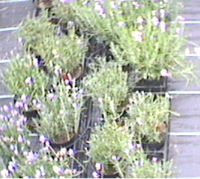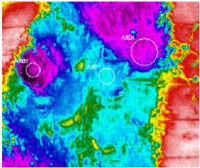Thermal images give thirsty plants a voice


Thermal imaging of plants could be used to help crop growers save valuable water in an increasingly water-scarce world.
Lancaster University is leading moves to develop a state-of-the-art irrigation system, which lets growers know when their plants are thirsty, thanks to a £1.49 million project funded by the Department for Environment Food and Rural Affairs, the Horticultural Development Council and industrial partners.
As plants become too dry they begin to show signs of stress and warm up. This warming shows up as distinct warm spots on a leaf viewed with a thermal imaging camera.
Conventional and thermal camera imaging systems on an irrigation boom would be passed over the crops at regular intervals collecting information about how much water each plant needed. This information would be fed into an automated irrigation system which would then robotically deliver a precise, targeted amount water to each plant, according to demand.
This could have a profound impact on horticulture and some types of agriculture, making more efficient use of limited water supply, reducing crop variability and waste and thereby saving growers money.
Within the next four years, scientists, working with horticulturalists and a consortium of 11 small and medium sized enterprises across the UK, hope to develop an automated high-tech watering device, of a type which has never been used before in the UK
The project also brings together Lancaster University researchers in the Centre of Sustainable Agriculture at the Lancaster Environment Centre with partners at the University of Dundee and industry experts at Pera Innovation and East Malling Research.
The new watering technology will be tested out on high value hardy nursery stock such as hydrangeas and conifers with the potential to roll out to other sectors of the industry at a later date.
Project co-ordinator Professor Bill Davies, Director of the Lancaster Environment Centre, said: "This technology is potentially revolutionary in that it lets the plant tell you when it is thirsty and exactly how much water it needs.
Most existing watering systems are very low tech and inefficient with some plants receiving three times as much water as others. This almost inevitably means a lack of uniformity in the crop and waste due to quality variation.
Through this system we are trying to double water use efficiency, which in itself would be impressive and important. If this works well it could have the potential to increase efficiency by ten times or more."
Mark Bacon, Director of Enterprise and Business Partnerships within the Lancaster Environment Centre, said: "This approach has enabled a consortium of forward-thinking businesses to come together and access funding and research expertise which would otherwise have been unavailable to them. Lancaster has more than 30 years of expertise in this area which we are keen to develop into a practical solution which will fit the needs of producers now and in the future as climate change begins to have a deeper effect."